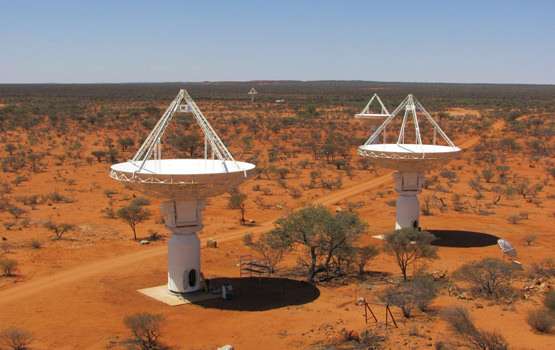ASKAP seeks out hydrogen content in distant galaxies

Ten billion years ago galaxies were brimming over with cold hydrogen gas, and stars were forming from this medium at ten times the rate of current galaxies, so what happened?
That is the question astronomers hope to answer in a study utilising CSIRO's Australian Square Kilometre Array Pathfinder (ASKAP) radio telescope, a collection of thirty-six dishes, six of which are situated in Western Australia.
The widely publicised recent detection of cosmic radio waves coming from galaxy PKS B1740-517 by the six WA dishes demonstrates the power of these telescopes and also the perfect radio-quiet conditions that exist in outback WA.
The radio waves were emitted by the black hole at the centre of the galaxy about five billion years ago, before the creation of our solar system, and they carry with them the "imprint" of cold hydrogen gas from the galaxy itself.
The hydrogen gas absorbs the radio waves at just one frequency creating a tiny blip that can identify not only the presence of hydrogen but also the galaxy's distance from Earth.
The distance is calculated by what is known as "redshift"—given the position that the blip would occupy from a nearby source, the actual position is shifted toward the red end of the spectrum by the galaxy's movement away from us, the amount of this shift indicates distance.
Mid West represents ideal radio-quiet zone
University of Sydney Professor of Astrophysics Elaine Sadler is leading the research team.
"If you put your radio telescope in most places in the world, that range of frequencies is drowned out by all the noise that we humans produce, mobile phones, radio and TV stations etc," Prof Sadler says.
The six WA dishes are located in a radio-quiet zone 300km inland from Geraldton, meaning radio waves in the required frequency range (700 to 1800 megahertz) can be detected.
"We'll be hunting for galaxies that are five to eight billion years old, a timespan that represents almost a quarter of the universe's history," Prof Sadler says.
"We want to learn how much hydrogen galaxies had in this period for forming stars, and until ASKAP we've had few tools for doing that."
Prof Sadler plans to study several hundred galaxies for the survey.
PKS B1740-517 was a strong radio source identified by the Parkes Radio Telescope a few years ago, and it was only the detection of the hydrogen signature that confirmed it was a distant galaxy.
Provided by Science Network WA





















